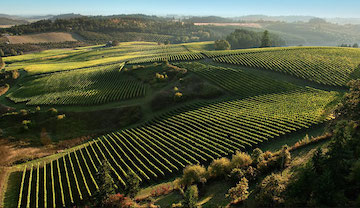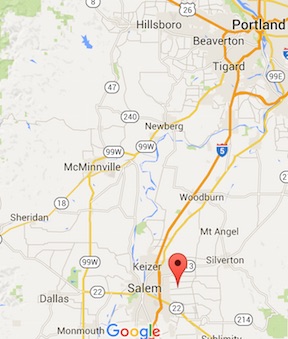Why Oregon is the Most Dynamic Wine Region in America
 Last week Nancy Keates investigated the Oregon wine industry for the Wall Street Journal. In general, the article profiled a number of folks who have spent lots of money building wineries, building homes in Oregon wine country and generally gentrifying their way to happiness and profit.
Last week Nancy Keates investigated the Oregon wine industry for the Wall Street Journal. In general, the article profiled a number of folks who have spent lots of money building wineries, building homes in Oregon wine country and generally gentrifying their way to happiness and profit.
However, buried in this story was a fascinating factoid: in 2014 the number of wineries in Oregon increased by 12% to 676. That’s HUGE! I don’t know how the figure was derived, but let’s assume it was fact checked.
Meanwhile, this summer the Oregon Wine Board released its annual report and found the following concerning growth of the Oregon wine industry in 2014 versus 2013:
• Vineyard operations in Oregon increased by 8 percent, to 1,027 in 2014
• Planted acres increased 14 percent to 27,390
• Sales increased 14 percent, to $430 million
• International sales increased 50%
These are big numbers that dwarf the overall U.S. wine industry numbers for 2014. They clearly are not sustainable indefinitely, but there is no reason to doubt that excellent growth will continue for at least few years as Oregon continues to impress and to attract investment.
I’ve been to Oregon three times in the past year and can report that not only are the wines WillametteValleyremarkably good (they have been for many years), but also the winemaking regions—particularly the Willamette Valley—are absolutely beautiful, as well as accessible.
In particular, from a hospitality perspective, the Willamette Valley is similar to both Napa and Sonoma insofar as it’s not far from a primary transportation and population hub (Portland). This is important not only because it allows easy access to wine country from that spot where most of the people live, visit and travel to, but also because support from the food, art and cultural world of a nearby sophisticated metropolis is what makes the difference between a successful wine country hospitality industry and a wildly successful wine country hospitality industry.
There is another key fact that makes Oregon my pick for the most dynamic wine region in America right now: Relatively low vineyard and land prices. While an acre of vineyards in Napa Valley can run between $275,000 and $350,000, a planted acre in Oregon’s Willamette Valley will run you between $75,000 to $100,000. This is also below the average price of a Sonoma County acre of vines.
Add another item to this parade of wonderfuls: The average price of a bottle of Oregon wine shipped direct to the consumer in 2014 was $40.00, considerably higher than the average price of wine shipped direct from both Sonoma County and Washington wineries.
Oh, and then there is the issue of Pinot Noir. The surge in Pinot sales over the past decade  is no fluke. Americans discover and liked the grape…very, very much. And there is no reason to believe they will be abandoning that love of Pinot Noir, a grape that as we know is Oregon’s signature wine.
is no fluke. Americans discover and liked the grape…very, very much. And there is no reason to believe they will be abandoning that love of Pinot Noir, a grape that as we know is Oregon’s signature wine.
All this helps go a long way toward explaining why Oregon is looking very good to investors. It means Oregon will continue to see pasture and orchard land transformed into vineyards. How the local community reacts to this transformation will be important to future wine industry development in the region.
Those who oppose the planting of more and more vineyards will certainly be reminded that with more vineyards comes more wine and more wineries. With more wine and more wineries come more visitors to the region. With more visitors to the region come more supporting amenities, more businesses and more jobs. With more jobs comes more residents and more homes. With more residents, homes and visitors come both a larger tax base and more stress on infrastructure.
It will be fascinating to watch and see if local communities can adequately plan for the ongoing transformation. It could go terribly wrong or be a model for other growing wine regions.
One thing that makes Oregon truly unique I mentioned earlier. Sixty percent of Oregon’s wine production is Pinot Noir. In the Willamette Valley Pinot Noir represents 70% of production. This doesn’t make Oregon or the Willamette Valley mono-varietal. But it’s pretty darned close. Napa Valley, with its commitment to Cabernet Sauvignon and Cabernet blends has demonstrated this isn’t a problem. However, Americans drink more Cabernet than they do Pinot Noir. If I were Oregon wineries I might think about spending promotional dollars on the promotion of Pinot Noir as much as I thought about spending promotional dollars on the promotion of Oregon wine.
Either way, there is no question that the sun is rising on Oregon and it looks to me like it’s going to shine pretty brightly for some time to come.

Tom, I too am dazzled with the quality, precision and value of Oregon wines. Pinot Noir is the gold standard, but Oregon Chardonnays may rightly claim to be among the very best – if not the very best – in the country. Oregon Pinot Gris is clearly the best in the country, and Pinot Blanc, though little is produced, can be exceptional. That’s all fine and dandy, but some of the most exciting wines that are not Pinot Noir are coming from Southern Oregon. I think you will find increasing interest and emphasis on those wines, as well as the long-neglected Walla Walla AVA, now sub-divided with The Rocks of Milton Freewater entirely within Oregon.
Paul,
You are absolutely correct. On every count. The thing is, the Oregon wine industry currently lives and breaths on Pinot. I don’t see that changing, but I think you are right that Southern Oregon wines (well beyond Pinot) will be getting much more attention. Additionally, the land there and the vineyards are even better values.
Spot on, Tom. I’ve visited Willamette Valley 6-7 times in recent years and I’m always taken by the quality, the growth in dining and tourism, and the beautiful scenery. One other point worth making is the hospitality. You still run into winemakers and owners when visiting tasting rooms in Oregon. Most all are happy to spend time and answer questions as well as pour their wines. I’ve visited Napa and Central Coast several times and love the areas but Oregon offers something really special.
Howard, yest that’s true about the owners. I think this is primarily a function of the fact that many Oregon wineries are relatively small. It’s why you meet owners at wineries in most other regions, Napa and Sonoma included, when the wineries are small.
Tom – this article is spot on. A native to the Willamette Valley, I am no stranger to the acres on acres on acres of vines. While Pinot Noir is the “cream of the crop” up here, like you said, it is Southern Oregon wines that have my heart – er, rather, taste buds.Nothing against Pinot Noir, as it is a delicious varietal… i just feel like that is all this valley has to offer! I used to work for a winery in Southern Oregon, constantly being exposed to richer, deep, and more complex wines. A buttery, aged Chardonnay, spicy Tempranillo, and earthy Dolcetto; can’t get anything like it up here in the Willamette!
Thank you for mentioning this, I felt it was missing from the article. As a student at SOWI, and a big fan of the Umpqua regions wonderful wines (especially the tempernillos and reislings I wonder why we weren’t mentioned?
SOWI is doing some absolutely wonderful things too! Wholeheartedly agree. #UCCStrong
#UVWine
Wonderful article. Thank you for writing about the goodness of Oregon. I would highly encourage you to look to Southern Oregon. You are missing 1/2 the story for the amazing variety of wines that are produced below the Willamette Valley. Start with wineries in Elkton, the tip of the Umpqua Calley AVA, head to Roseburg and continue all the way down to Jackson County. You will be blessed with an amazing adventure. We hope you to see you in Southern Oregon soon!
Nice article. I’m convinced that Oregon’s wine industry will continue to boom over the next 5 – 10 years, because it is indeed that “next frontier.” Moreover, I believe that it has the attention of the big boys from California and elsewhere. Joe Wagner essentially announced he’s planning his ‘next Meomi’ in Oregon. KJWE has interests in the state’s viticulture, and I believe it’s inevitable that brand acquisitions are made on existing brands once supply’s aligned with growth potential.
It’s not a matter of ‘if’ but ‘when.’ I’m not a farmer, but I would guess that farming grapes could very well be more lucrative than grass seed (which has historically been the Willamette Valley’s agricultural lifeblood). At the very least, we’ll see further diversification of acerage. And the southern part of the state has the potential for producing solid wines to fuel the demand for brands in the $10 – $20 price point that is the ‘sweet spot’ for today’s cosumer.
Not to sound like “Mr. BuzzKill,” but Oregon is coming off am atypically stupendous vintage: 2012.
The state’s Pinot Noirs are challenged by too many cold and rainy vintages each decade — unlike California.
You can’t grow your business if the public shuts its wallets and purses to purchases in “off” years.
And frequent “off” years in Oregon is more the norm than the exception — unlike California.
[…] Wark wrote, Oregon is the most dynamic wine region in the country, and there are some regions in southern Oregon that have completely captured our winemakers’ […]
[…] Wark wrote, Oregon is the most dynamic wine region in the country, and there are some regions in southern Oregon that have completely captured our winemakers’ […]